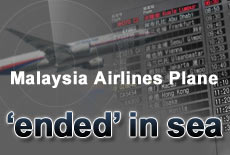|
 |
"Where we're at right now, four weeks since this plane disappeared, we're much, much closer," said aviation expert Geoffrey Thomas, the editor-in-chief of AirlineRatings.com. "But, frustratingly, we're still miles away from finding it. We need to find some piece of debris on the water; we need to pick up the ping."
If it doesn't happen, the only hope for finding the plane may be a full survey of the Indian Ocean floor, an operation that would take years and an enormous international operation.
Hishammuddin said there were no more new satellite images or data that can provide new leads for searchers. The focus now is fully on the ocean search, he said.
Two ships, the Australian navy's Ocean Shield and the British HMS Echo, carrying sophisticated equipment that can hear the recorders' pings, returned on Saturday to an area investigators hope is close to where the plane went down. They concede the area they have identified is a best guess.
Up to 13 military and civilian planes and nine other ships took part in the search Saturday, the Australian agency coordinating the search said.Because the U.S. Navy's pinger locator can pick up signals to a depth of 6,100 meters (20,000 feet), it should be able to hear the plane's data recorders even if they are in the deepest part of the search zone - about 5,800 meters (19,000 feet). But that's only if the locator gets within range of the black boxes - a tough task, given the size of the search area and the fact that the pinger locator must be dragged slowly through the water at just 1 to 5 knots (1 to 6 mph).
Australian Air Chief Marshal Angus Houston, head of the joint agency coordinating the operation, acknowledged the search area was essentially a best guess, and noted the time when the plane's locator beacons would shut down was "getting pretty close."
The overall search area is a 217,000-square-kilometer (84,000-square-mile) zone in the southern Indian Ocean, about 1,700 kilometers (1,100 miles) northwest of the western Australian city of Perth.